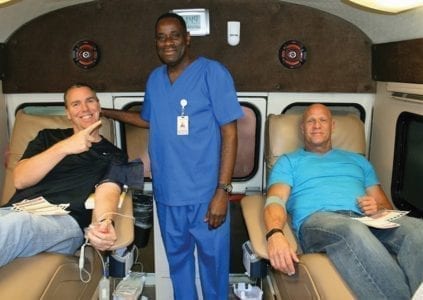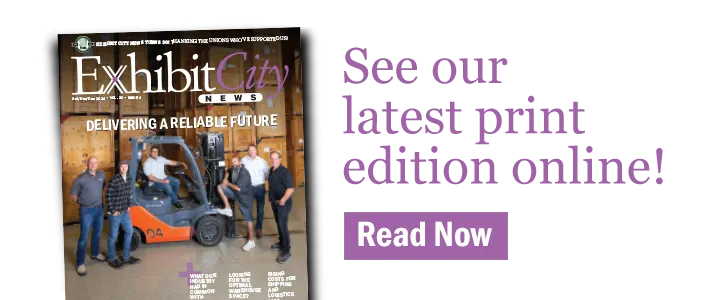 Part-time work for full-time pay
Part-time work for full-time pay
Ask someone on your install and dismantle (I&D) crew why he’s in the business, and you might get that answer. A hard worker who consistently works overtime and double-time can earn $100,000 or more for 200 days of work. Although workers enjoy the benefits of one-and-one-half and double times their regular rate, the overtime intensity is costly to their long-term well-being.
Physical demands of working overtime
When considering work-related risks of physical jobs, we often think of safety first. In recent decades, proper worker training and equipment has significantly reduced work-related injuries. According to OSHA, the injuries and illnesses per 100 workers dropped from 10.9 in 1972 to 3.3 in 2014.1
The more insidious risks are the long-term effects of consistent work-related aggravations. Musculoskeletal disorders (MSDs) are health problems affect the muscles, ligaments, joints, and other parts of the muscular system. Work-related MSDs are caused by a combination of physical, organizational, and individual factors that act simultaneously and synergistically on the body.
The most strenuous work situations happen when postures are sustained for long periods of time without alteration (static postures) or are repeated numerous times (repetitive tasks). Long work cycles without rest to recover compound strains.2
No matter their age or experience, the most common repetitive task for all laborers is walking. While most office workers struggle to earn their 10,000 steps, the FitBit record holder at TS Crew of Orlando, FL walked 40,000 steps (or 20 miles) in a single day. And often, these steps are on concrete surfaces that offer no give. Workers are required to wear closed-toed shoes that protect feet from dropped objects, but sole support is often compromised. (The worst offender is a pair of cowboy boots, which are designed for people riding horses, not walking on concrete.) Additionally, workers are likely carrying tool belts that add weight. The result is repetitive shock to joints and fatigue.
Exhaustive work cycles
“Exhibitors may not appreciate the sacrifice the I&D workers make in their daily lives,” said Chris Griffin, CEO of I&D company TS Crew in Orlando, FL and Las Vegas, NV. “It’s a hard physical job that can cause hardship on families as well.”
Workers must completely prepare the show floor before opening time, which may require late nights and fast pace. Although breaks are required, sleep is the only remedy for loss of sleep. Additionally, most tradeshows require that move-in and set-up happens on the weekends, when most social events occur. After the crowds leave – right around dinner time – the same crews return to dismantle and pack-out the properties even faster than before. Physical aches, exhaustion, and absence are tough on the workers’ bodies, minds, and families.
Job insecurity
Cyclical work has regular periods of lay-offs and re-hiring that causes stressful uncertainty about employment. Many leave to find more stable jobs, causing a workforce shortage that drives laborers to work overtime to complete projects. The intensity of both under-and-over employment creates a “pressure cooker” atmosphere that can overwhelm and exhaust employees.3
The intensity and job insecurity can trigger mental health issues. Unfortunately, many workers go undiagnosed and untreated. Construction-type jobs are still predominantly male and the typical “tough guy” culture creates a barrier for workers to seek help. For men between the ages of 25 and 54 in the United States, suicide is the second leading cause of death. The construction industry, which is a similar trade, is one of the top nine occupations at risk for suicide.4
Aging workforce
Adding to the job insecurity, baby boomers are continuing to work, creating an older workforce that is aging in a career that’s intensely physical. Local 510 in San Francisco, CA has workforce with a median age of 53. Aging can lead to an increase of MSDs prevalence, due to a reduction in body resistance.2 For the blue collar worker, their hands-on profession requires that they are able-bodied. Older workers are not as quick to recover from a long day. For unbearable aches and pains, they might self-medicate with Advil, Tylenol, or something much stronger.
Finding relief
I&D companies require that their employees remain 100% alert and dismiss them for intoxication of any kind. Once a company establishes this standard, workers respect the rules. However, prescription drug abuse is hard to detect. Like alcohol, the substance is legal and socially accepted. Prescriptions are even the doctor’s orders.
Baby boomers, who are the majority of I&D workers, are a generation of the psychedelic 60s. They were conditioned to turn to drugs to escape or cope. Now there is a nationwide trend of baby boomers abusing Vicadin, Oxy, and other opiates.5
Prescription drug abuse can quickly become dangerous, especially for older people. Their slower metabolisms can cause substances to build-up in their systems. If they continue taking drugs, or mix substances, they might accidentally overdose. The loss of Prince earlier this year is a tragic example.
Building a culture of well-being
In addition to the great pay and flexible schedule, I&D workers also find satisfaction in the brotherhood culture. “They’re like a football team working together,” said Griffin. They share in the struggles of working long hours in a few short days. In the end, they share in the triumph of having built a physical structure.
Comradery also means looking out for each other’s safety. Now is a time when workers can learn to look out for each other’s wellbeing. For effective impact, the organization must drive the shift. TS Crew is a progressive I&D company that added a wellness program for their workers. Their activities include FitBit challenges with attractive prizes, like an extra vacation day. They also educate workers on healthy habits, such as meal prepping with mason jar lunches.
To learn more, research initiatives that are being taken in the construction industry. Resources for suicide prevention: http://carsonjspencer.org/files/6114/4106/0974/Construction_Industry_Blueprint_for_Suicide_Prevention.pdf
References
- https://www.osha.gov/oshstats/commonstats.html
- https://oshwiki.eu/wiki/Introduction_to_musculoskeletal_disorders
- http://carsonjspencer.org/files/6114/4106/0974/Construction_Industry_Blueprint_for_Suicide_Prevention.pdf
- http://www.forbes.com/sites/amymorin/2016/05/21/what-construction-workers-could-teach-other-industries-about-mental-health-awareness/#341392449a23
- http://www.wsj.com/articles/aging-baby-boomers-bring-drug-habits-into-middle-age-1426469057































